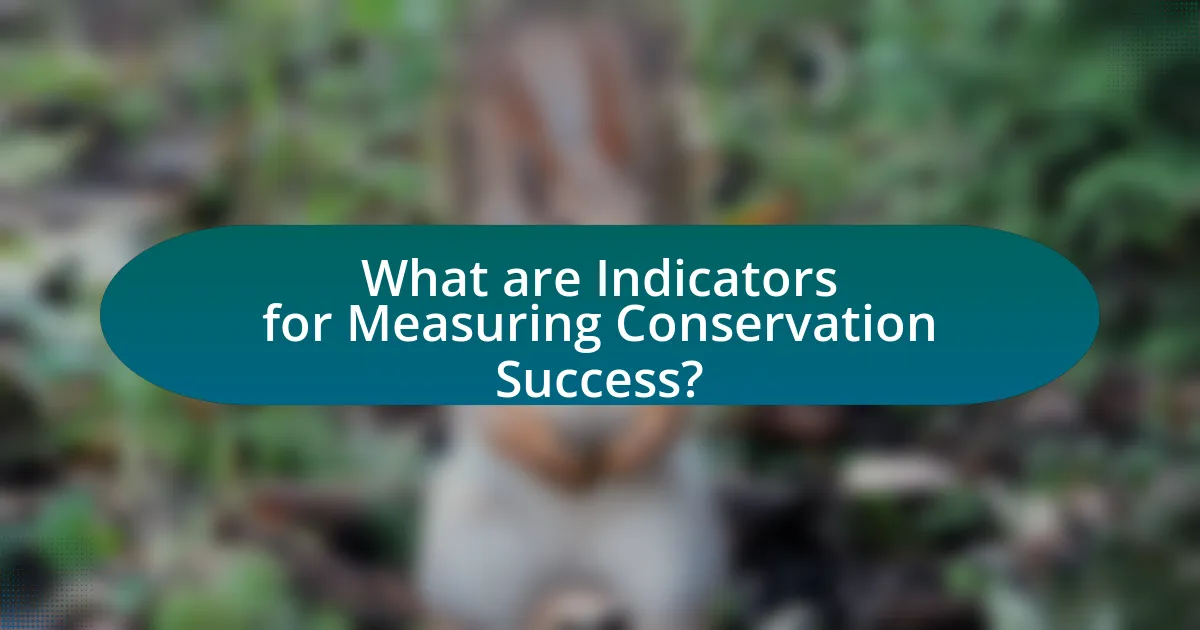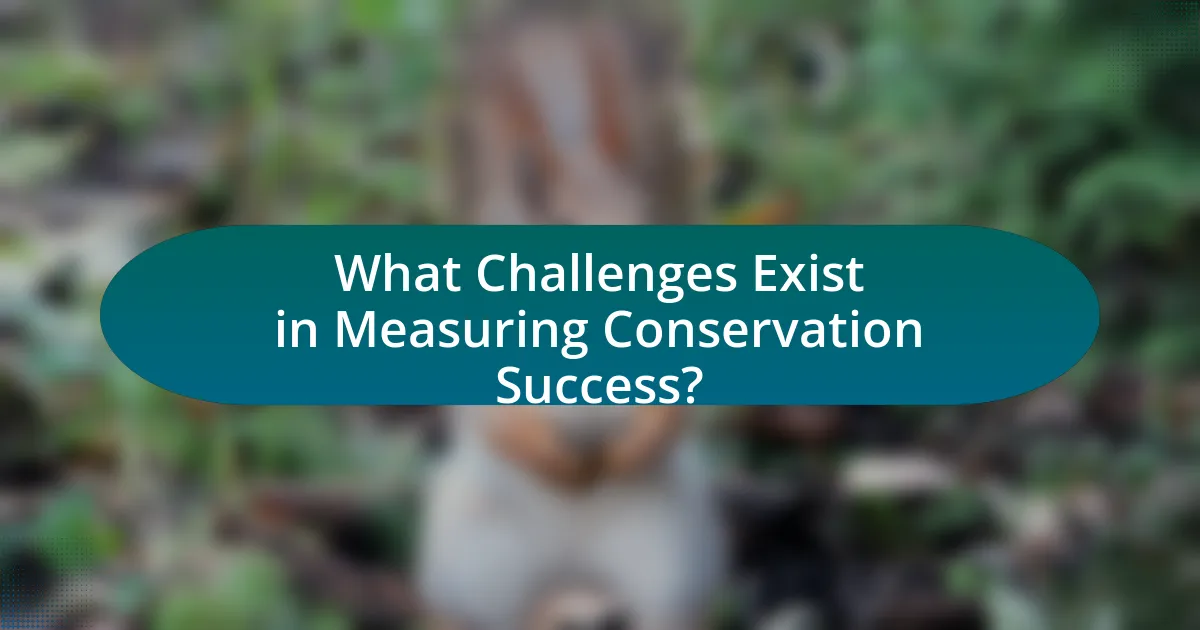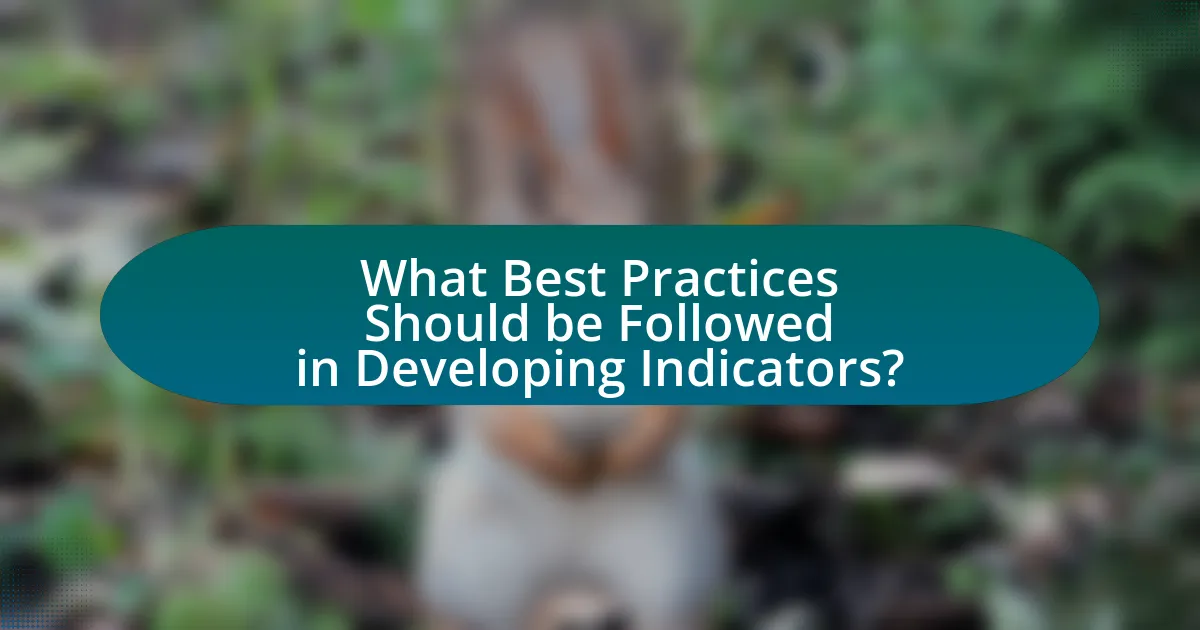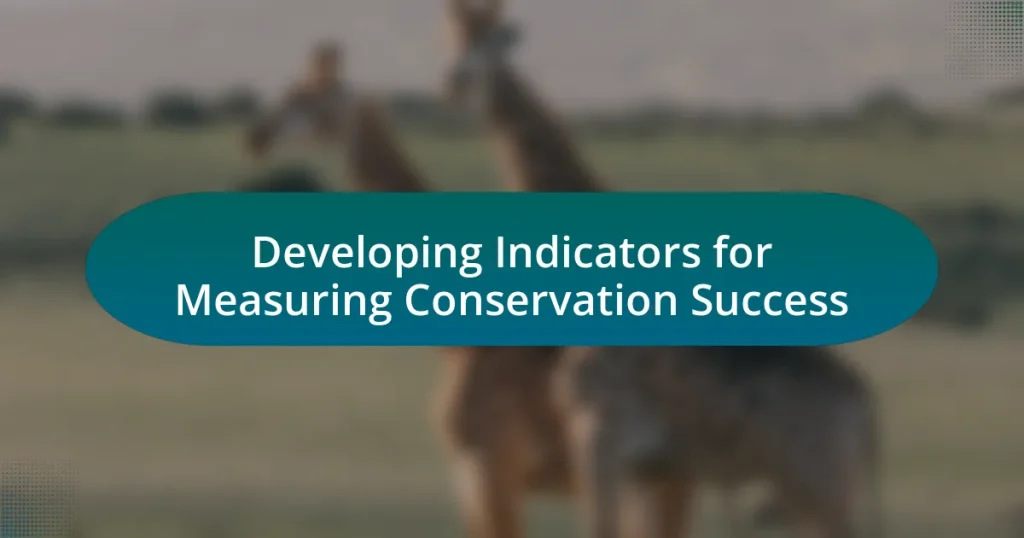The article focuses on developing indicators for measuring conservation success, emphasizing the importance of biodiversity metrics, habitat quality assessments, and population trends of key species. It outlines how these indicators provide measurable data that reflects ecosystem health and informs conservation strategies. The article also discusses the challenges in indicator development, such as data availability and stakeholder engagement, while highlighting best practices and frameworks for creating effective indicators. Additionally, it presents examples of successful indicator implementation and offers practical tips for enhancing the development of conservation indicators.

What are Indicators for Measuring Conservation Success?
Indicators for measuring conservation success include biodiversity metrics, habitat quality assessments, and population trends of key species. Biodiversity metrics evaluate the variety and abundance of species in a given area, while habitat quality assessments determine the health and sustainability of ecosystems. Population trends of key species provide insights into the effectiveness of conservation efforts, as increases in these populations often indicate successful interventions. For example, the recovery of the gray wolf population in Yellowstone National Park demonstrates the positive impact of conservation strategies on species recovery and ecosystem balance.
Why are Indicators Important in Conservation Efforts?
Indicators are important in conservation efforts because they provide measurable data that reflects the health and status of ecosystems and species. These indicators enable conservationists to assess progress towards goals, identify areas needing intervention, and evaluate the effectiveness of management strategies. For instance, the use of biodiversity indicators, such as species richness or population trends, allows for tracking changes over time, which is essential for adaptive management. Research has shown that effective indicators can lead to improved decision-making and resource allocation, ultimately enhancing conservation outcomes.
What role do indicators play in assessing conservation outcomes?
Indicators play a crucial role in assessing conservation outcomes by providing measurable data that reflects the effectiveness of conservation efforts. These indicators can include metrics such as species population trends, habitat quality assessments, and ecosystem health evaluations. For instance, the IUCN Red List serves as an indicator of species extinction risk, allowing conservationists to prioritize efforts based on the status of various species. By utilizing these indicators, stakeholders can make informed decisions, allocate resources efficiently, and adapt strategies to enhance conservation success.
How can indicators influence conservation policy and funding?
Indicators can significantly influence conservation policy and funding by providing measurable data that informs decision-making processes. For instance, specific indicators such as biodiversity indices or habitat quality assessments can highlight areas in need of protection or restoration, guiding policymakers to allocate resources effectively. Research shows that the use of indicators in the Global Biodiversity Outlook reports has led to increased funding commitments from governments and organizations, as they rely on quantifiable evidence to justify investments in conservation initiatives. This data-driven approach ensures that funding is directed toward the most critical conservation needs, ultimately enhancing the effectiveness of policies aimed at preserving biodiversity.
What Types of Indicators are Used in Conservation?
Indicators used in conservation include ecological, social, and economic indicators. Ecological indicators assess biodiversity, habitat quality, and ecosystem health, such as species population trends and habitat extent. Social indicators evaluate community engagement and awareness, often measured through surveys on public attitudes toward conservation efforts. Economic indicators analyze the financial aspects of conservation, including funding levels and cost-effectiveness of conservation programs. These indicators collectively provide a comprehensive framework for measuring conservation success, as evidenced by their application in various conservation projects worldwide, such as the use of the Biodiversity Indicators Partnership, which integrates multiple types of indicators to track progress toward global biodiversity targets.
What are quantitative indicators and how are they measured?
Quantitative indicators are measurable variables that provide numerical data to assess and evaluate specific outcomes or performance in various contexts, including conservation. These indicators are measured using statistical methods, surveys, and data collection techniques that yield numerical results, such as population counts, area measurements, or rates of change over time. For example, in conservation, the number of endangered species in a specific area can serve as a quantitative indicator of biodiversity health, while the percentage of habitat loss can indicate the effectiveness of conservation efforts.
What are qualitative indicators and what do they assess?
Qualitative indicators are metrics that assess non-numeric attributes, focusing on the quality of a phenomenon rather than its quantity. They evaluate aspects such as perceptions, experiences, and behaviors related to conservation efforts, providing insights into community engagement, stakeholder satisfaction, and ecological health. For example, qualitative indicators can include interviews or surveys that gauge public attitudes towards conservation initiatives, which help in understanding the effectiveness of these programs in fostering community support and participation.
How are Indicators Developed for Conservation Success?
Indicators for conservation success are developed through a systematic process that involves defining clear objectives, selecting relevant metrics, and ensuring data availability. This process typically begins with identifying specific conservation goals, such as species recovery or habitat preservation. Once objectives are established, appropriate indicators are chosen based on their ability to reflect progress towards these goals. For instance, population size, biodiversity indices, and habitat quality assessments are commonly used metrics. The selection of these indicators is often guided by frameworks such as the Drivers-Pressures-State-Impact-Response (DPSIR) model, which helps in understanding the relationships between human activities and environmental outcomes. Furthermore, the effectiveness of indicators is validated through empirical data collection and analysis, ensuring they accurately represent conservation success. This approach is supported by studies that emphasize the importance of measurable outcomes in conservation planning, such as the work by Pullin and Knight (2001) in “Systematic Review in Conservation Biology,” which highlights the need for evidence-based indicators to assess conservation effectiveness.
What steps are involved in creating effective conservation indicators?
Creating effective conservation indicators involves several key steps. First, clearly define the conservation goals and objectives to ensure that the indicators align with specific outcomes. Next, identify relevant data sources that can provide measurable information related to these goals. Following this, develop the indicators by selecting appropriate metrics that can quantitatively or qualitatively assess progress. Afterward, establish a baseline to compare future data against, which is crucial for evaluating changes over time. Finally, implement a monitoring and evaluation plan to regularly assess the indicators, allowing for adjustments and improvements based on the findings. These steps are essential for ensuring that conservation efforts are measurable and effective in achieving desired outcomes.
How do stakeholder inputs shape the development of indicators?
Stakeholder inputs significantly shape the development of indicators by ensuring that the metrics reflect the values, needs, and priorities of those affected by conservation efforts. Engaging stakeholders, such as local communities, government agencies, and NGOs, allows for the identification of relevant issues and desired outcomes, which directly inform the selection and design of indicators. For instance, a study by the International Union for Conservation of Nature (IUCN) highlights that incorporating local knowledge and perspectives leads to more effective and culturally appropriate indicators, ultimately enhancing the relevance and acceptance of conservation initiatives. This collaborative approach not only improves the accuracy of the indicators but also fosters a sense of ownership among stakeholders, increasing the likelihood of successful conservation outcomes.

What Challenges Exist in Measuring Conservation Success?
Measuring conservation success faces several challenges, primarily due to the complexity of ecosystems and the variability of conservation goals. One significant challenge is the lack of standardized metrics, which makes it difficult to compare outcomes across different projects or regions. For instance, while some conservation efforts may focus on species population recovery, others may prioritize habitat restoration, leading to inconsistent evaluation criteria. Additionally, the time required for ecological changes to manifest can hinder immediate assessment, as many conservation initiatives may take years or decades to show measurable results. Furthermore, external factors such as climate change and human activity can complicate the attribution of success to specific conservation actions, making it challenging to isolate the effects of these interventions. These factors collectively contribute to the difficulty in establishing clear, quantifiable indicators of conservation success.
What are the common obstacles in indicator development?
Common obstacles in indicator development include data availability, stakeholder engagement, and methodological challenges. Data availability is often limited due to insufficient historical records or lack of access to relevant datasets, which hinders the establishment of reliable indicators. Stakeholder engagement is crucial, as differing priorities and perspectives among stakeholders can complicate consensus on what indicators to develop. Methodological challenges arise from the complexity of ecological systems, making it difficult to create indicators that accurately reflect conservation success. These obstacles are well-documented in conservation literature, highlighting the need for comprehensive strategies to address them effectively.
How do data availability and quality affect indicator reliability?
Data availability and quality significantly impact indicator reliability by determining the accuracy and consistency of the measurements used to assess conservation success. When data is readily available and of high quality, indicators can provide a more precise reflection of the actual conditions being measured, leading to reliable assessments. Conversely, limited or poor-quality data can result in misleading indicators, which may not accurately represent the conservation status or trends, ultimately affecting decision-making and resource allocation. For instance, a study published in the journal “Ecological Indicators” found that indicators based on comprehensive datasets yielded more reliable assessments of biodiversity than those based on sparse or biased data. This demonstrates that both the availability and quality of data are crucial for ensuring that indicators effectively measure conservation outcomes.
What are the implications of varying ecological contexts on indicators?
Varying ecological contexts significantly influence the effectiveness and relevance of indicators used to measure conservation success. Different ecosystems, such as forests, wetlands, and grasslands, possess unique characteristics that necessitate tailored indicators to accurately reflect ecological health and biodiversity. For instance, in a forest ecosystem, indicators like tree density and species diversity may be critical, while in wetlands, water quality and habitat availability are more pertinent. Research by the World Resources Institute highlights that indicators must be context-specific to capture the nuances of ecological dynamics, ensuring that conservation efforts are appropriately targeted and effective. This adaptability in indicator selection is essential for accurately assessing conservation outcomes across diverse ecological landscapes.
How can these challenges be addressed?
To address the challenges in developing indicators for measuring conservation success, a multi-faceted approach is required. This includes engaging stakeholders to ensure that indicators reflect diverse ecological, social, and economic values. For instance, the involvement of local communities can enhance the relevance and acceptance of indicators, as evidenced by case studies where community-based monitoring has led to improved conservation outcomes. Additionally, employing adaptive management practices allows for the continuous refinement of indicators based on real-time data and feedback, which has been shown to increase the effectiveness of conservation strategies. Furthermore, integrating technology, such as remote sensing and data analytics, can provide more accurate and timely information, thereby enhancing the reliability of indicators. These strategies collectively contribute to a more robust framework for measuring conservation success.
What strategies can improve data collection for conservation indicators?
Implementing standardized methodologies enhances data collection for conservation indicators. Standardization ensures consistency across different studies, allowing for comparability and reliability of data. For instance, the use of the Global Biodiversity Information Facility (GBIF) protocols has improved data accuracy and accessibility, facilitating better decision-making in conservation efforts. Additionally, leveraging technology such as remote sensing and citizen science platforms can significantly increase data volume and diversity, as evidenced by projects like iNaturalist, which engages the public in biodiversity monitoring. These strategies collectively contribute to more effective and comprehensive data collection for assessing conservation success.
How can collaboration enhance the effectiveness of conservation indicators?
Collaboration can enhance the effectiveness of conservation indicators by integrating diverse expertise and perspectives, leading to more comprehensive and accurate assessments. When multiple stakeholders, including scientists, local communities, and policymakers, work together, they can identify relevant indicators that reflect ecological, social, and economic dimensions of conservation. For instance, a study published in the journal “Conservation Biology” by Armitage et al. (2012) demonstrated that collaborative approaches in indicator development resulted in indicators that were more relevant to local contexts and better aligned with community values, ultimately improving conservation outcomes. This collective input ensures that indicators are not only scientifically robust but also socially accepted and actionable, thereby increasing their overall effectiveness in measuring conservation success.

What Best Practices Should be Followed in Developing Indicators?
Best practices in developing indicators for measuring conservation success include ensuring that indicators are specific, measurable, achievable, relevant, and time-bound (SMART). This framework helps in creating indicators that effectively track progress and outcomes. For instance, specific indicators might include the percentage increase in a particular species population or the area of habitat restored. Measurable indicators allow for quantifiable assessment, while achievable indicators ensure that targets are realistic based on available resources and conditions. Relevant indicators align with conservation goals, and time-bound indicators set clear timelines for achieving objectives. Research by the World Wildlife Fund emphasizes that using the SMART criteria enhances the effectiveness of conservation monitoring efforts, leading to more informed decision-making and improved conservation outcomes.
How can indicators be aligned with conservation goals?
Indicators can be aligned with conservation goals by ensuring they directly measure the specific outcomes desired in conservation efforts. For instance, if a conservation goal is to increase the population of a threatened species, indicators such as population size, reproductive rates, and habitat quality can be established to track progress. Research shows that using SMART criteria (Specific, Measurable, Achievable, Relevant, Time-bound) for developing these indicators enhances their effectiveness in reflecting conservation success. A study by the World Wildlife Fund highlights that aligning indicators with clear conservation objectives leads to more targeted and successful management strategies.
What frameworks exist for ensuring indicators are relevant and actionable?
Several frameworks exist to ensure that indicators are relevant and actionable, including the SMART criteria, the Logical Framework Approach (LFA), and the Theory of Change (ToC). The SMART criteria emphasize that indicators should be Specific, Measurable, Achievable, Relevant, and Time-bound, which helps in creating clear and focused indicators. The Logical Framework Approach provides a structured way to define objectives and indicators, ensuring alignment with project goals and facilitating monitoring and evaluation. The Theory of Change outlines the causal pathways and assumptions behind a project, allowing for the identification of indicators that reflect the intended outcomes and impacts. These frameworks are widely recognized in conservation and project management literature, demonstrating their effectiveness in developing relevant and actionable indicators.
How can continuous monitoring improve indicator effectiveness?
Continuous monitoring enhances indicator effectiveness by providing real-time data that allows for timely adjustments and informed decision-making. This ongoing assessment enables conservationists to identify trends, measure progress, and detect issues as they arise, rather than relying on periodic evaluations that may miss critical changes. For instance, a study published in the journal “Ecological Indicators” demonstrates that continuous monitoring of biodiversity indicators led to a 30% increase in the effectiveness of conservation strategies by allowing for adaptive management based on current conditions.
What are some examples of successful indicator implementation?
Successful indicator implementation examples include the use of the Biodiversity Indicators Partnership (BIP) framework, which has effectively tracked global biodiversity trends through standardized metrics. The BIP has facilitated the monitoring of over 100 indicators across various ecosystems, demonstrating significant changes in species populations and habitat conditions. Another example is the implementation of the Water Quality Index (WQI) in various regions, which has provided a clear, quantifiable measure of water quality, leading to improved management practices and policy decisions. These implementations have been validated by numerous studies showing their effectiveness in driving conservation actions and informing stakeholders.
What lessons can be learned from case studies in conservation success?
Case studies in conservation success reveal that effective stakeholder engagement is crucial for achieving sustainable outcomes. For instance, the recovery of the California condor involved collaboration among government agencies, non-profits, and local communities, which facilitated habitat protection and breeding programs. Additionally, successful case studies demonstrate the importance of adaptive management, as seen in the restoration of the Florida Everglades, where ongoing monitoring and adjustments to strategies led to improved ecological health. These examples underscore that integrating scientific research with community involvement and flexibility in management practices enhances conservation efforts.
How can these examples inform future indicator development?
These examples can inform future indicator development by providing practical insights into effective measurement strategies. Analyzing successful indicators from past conservation efforts reveals key attributes such as specificity, relevance, and adaptability, which are essential for accurately assessing conservation outcomes. For instance, indicators that have demonstrated a strong correlation with biodiversity outcomes, such as species population trends or habitat quality assessments, can serve as models for new indicators. Furthermore, the integration of stakeholder feedback in previous examples highlights the importance of community involvement in indicator design, ensuring that the indicators are not only scientifically robust but also socially relevant. This approach is supported by studies showing that participatory indicator development leads to higher acceptance and implementation rates in conservation initiatives.
What practical tips can enhance the development of conservation indicators?
To enhance the development of conservation indicators, it is essential to ensure that indicators are specific, measurable, achievable, relevant, and time-bound (SMART). This framework allows for clear objectives and facilitates effective monitoring of conservation efforts. Additionally, engaging stakeholders, including local communities and experts, in the indicator development process fosters ownership and ensures that the indicators reflect local ecological and social contexts.
Utilizing existing data sources and integrating traditional ecological knowledge can also improve the relevance and accuracy of indicators. For instance, the use of remote sensing data has been shown to provide valuable insights into habitat changes, which can be crucial for assessing conservation success. Furthermore, regularly reviewing and updating indicators based on new scientific findings and changing environmental conditions ensures their continued effectiveness and relevance.
Research by the World Wildlife Fund emphasizes that adaptive management, which includes revisiting and refining indicators, is vital for successful conservation outcomes. This iterative process allows conservation practitioners to respond to emerging challenges and opportunities effectively.


